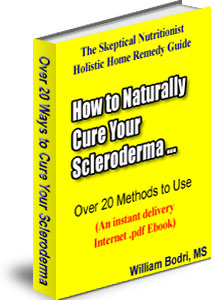
Scleroderma, an autoimmune disease of the connective tissue, is characterized by the formation of scar tissue in the skin and organs of the body. While the cause of scleroderma is not known, genetic and environmental factors are known to play an important role in its occurrence. This disease, which is more frequent in females than in males, can be divided into two major groups, diffuse and limited, depending upon the degree and location of skin involvement. The diffuse type, also known as systemic sclerosis, is more widespread over the body and also involves internal organs.
Autoimmune diseases are illnesses which occur when the body's tissues are attacked by its own immune system. The Ayurvedic treatment of scleroderma hence first focuses on regulating the immune system by using medicines like Ashwagandha (Withania somnifera), Shatavari (Asparagus racemosus), Guduchi (Tinospora cordifolia), Yashtimadhuk (Glycerrhiza glabra), Pippali (Piper longum), Rasna (Pluchea lanceolata) and Manjishtha (Rubia cordifolia).
Since fibrosis (scar formation) is the hallmark of this disease, the next obvious principle of treatment is reduction or reversal of fibrosis, wherever present in the body. For this, medicines used are: Punarnavadi Guggulu, Gokshuradi Guggulu, Rasayan Vati, Arogya Vardhini, Yashtimadhuk, Amalaki (Emblica officinalis), Guduchi, Gokshur (Tribulus terrestris), Kutaj (Holarrhina antidysentrica), Kutki (Picrorrhiza kurroa), Saariva (Hemidesmus indicus), Musta (Cyperus rotundus) and Patol (Tricosanthe dioica).
In addition, patients need to be treated for the specific tissue, organ or system involvement that they are suffering from. Involvement of the skin causes redness, swelling, itching and pain; and gradually leads to skin hardening and limitation of movement. These symptoms can be treated using local ointments and medicines like Arogya Vardhini, Kaishor Guggulu, Yashtimadhuk, Manjishtha, Guduchi and Gokshur. Scleroderma causes acid reflux in the esophagus (food pipe) causing heartburn. This can be treated using medicines like Shankh Bhasma, Kamdudha Vati and Laghu Sutshekhar, in addition to taking appropriate preventive measures.
Scleroderma frequently causes Reynaud's phenomenon, a condition in which the tips of fingers, toes, nose, tongue and ears turn blue, white and then red after exposure to cold, heat or even with an emotional upset. Scleroderma also causes the capillaries of the face, lips, mouth and fingers to dilate, creating tiny, red, blanching spots called telangiectasias. Both these conditions can be treated using medicines like Tapyadi Loha, Manjishtha and Saariva. A highly elevated blood pressure is best treated with modern anti-hypertensive medications.
Inflammation of the lungs can be treated using medicines like Kantakari (Solanum surattense), Brihat Kantakari (Solanum indicum), Behada (Terminalia bellerica), Yashtimadhuk, Pippali, Pushkarmool (Inula racemosa) and Sitopaadi Churna. By affecting the large bowel, scleroderma can cause either severe constipation or diarrhea. These conditions can be treated using medicines like Triphala (Three fruits), Kutki, Psyllium (Plantago ovata), Musta and Kutaj.
Scleroderma is a medical condition with a lot of unanswered questions. The conventional management of scleroderma is directed towards treating the individual features that are most troublesome. The addition of Ayurvedic treatment can definitely help to reverse the basic pathology, and improve the overall outlook of this disease.
Dr. A. A. Mundewadi is Chief Ayurvedic Physician at Mundewadi Ayurvedic Clinic based at Thane, Maharashtra, India. He is available as an online Ayurvedic Consultant at http://www.ayurvedaphysician.com
The online clinic offers Ayurvedic treatment for all chronic and refractory health problems. Dr. A. A. Mundewadi uses high quality herbal extracts in tablet form, which are easy to take, effective and safe for long-term use.
Dr. A. A. Mundewadi, B.A.M.S., has clinical experience of 23 years and clinical research experience of 9 years. He has conducted extensive research in HIV infection, Schizophrenia and many other chronic diseases.
Article Source: http://EzineArticles.com/?expert=Abdulmubeen_Mundewadi
http://EzineArticles.com/?Scleroderma---Ayurvedic-Herbal-Treatment&id=1571988







